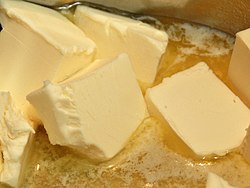 | |
| Alternative names | Danish butter cookies |
|---|---|
| Type | Cookie |
| Place of origin | Denmark |
| Main ingredients | Butter, flour, sugar |
Butter cookies, also known as Danish butter cookies, are cookies originating in Denmark consisting of butter, flour, and sugar. [1] They are similar to shortbread cookies.
Contents
The butter cookie is often categorized as a "crisp cookie" due to its texture, caused in part by the quantity of butter and sugar. It is generally necessary to chill its dough to enable proper manipulation and handling.
Butter cookies at their most basic have no flavoring, but they are often flavored with vanilla, chocolate, and coconut, and/or topped with sugar crystals. They also come in a variety of shapes such as circles, squares, ovals, rings, and pretzel-like forms, and with a variety of appearances, including marbled, checkered or plain. [2] Using piping bags, twisted shapes can be made. In some parts of the world, such as Europe and North America, butter cookies are often served around Christmas time. [3] Butter cookies are also a very popular gift in Hong Kong, especially during Lunar New Year. [4] [5]

